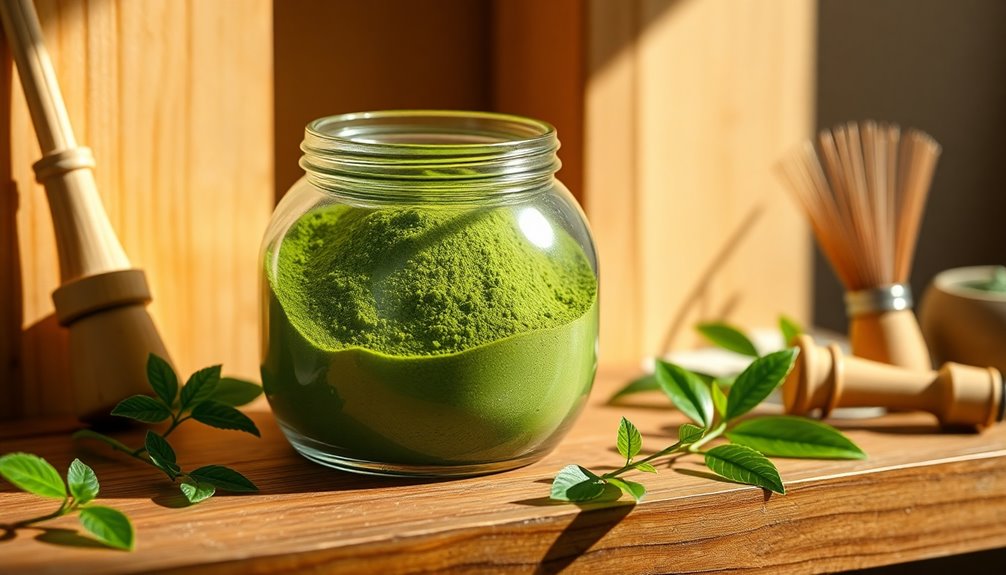To maximize your matcha's shelf life, store it in an airtight, opaque container made of ceramic or tin. Keep it in a cool, dark, and dry place, ideally under 60% humidity. If you haven't opened it yet, refrigerating can extend its freshness. Once opened, try to consume it within 1-2 months. Avoid glass containers and guarantee you reseal promptly after use to limit air exposure. For long-term storage, freezing matcha in vacuum-sealed bags works wonders, too. Monitor for changes in color, aroma, and texture to verify quality. Keep reading to explore more tips and creative uses for your matcha!
Key Takeaways
- Store matcha in high-quality, airtight, opaque containers to limit exposure to air and light, preserving freshness.
- Keep matcha in a cool, dark, and dry environment; refrigeration is ideal for unopened packaging.
- Consume opened matcha within 1-2 months and reseal containers promptly to minimize air exposure.
- For long-term storage, freeze matcha in airtight, vacuum-sealed bags and consume within six months for optimal quality.
- Regularly check for changes in color, aroma, and texture to assess matcha freshness and quality.
Importance of Proper Storage

When it comes to enjoying matcha at its best, proper storage is vital. This delicate green powder is sensitive to heat, humidity, and light, which can quickly diminish its quality and flavor.
Using an airtight container is essential, as it keeps matcha protected from being exposed to air, preventing oxidation that leads to a loss of color, aroma, and nutrients. For unopened matcha, refrigeration can help extend the shelf life considerably.
Once opened, you should consume it within 1-2 months for ideal freshness. Additionally, storing matcha in opaque, non-reactive containers shields it from light exposure, which can degrade its chlorophyll and cause color fading.
Regularly check for any changes in color or aroma to confirm it's at its best.
Recommended Storage Conditions

To maintain matcha's exceptional flavor and vibrant color, it is crucial to store it under specific conditions. Use an airtight container to limit air exposure, which can lead to oxidation. The ideal storage environment is cool, dark, and dry, away from direct sunlight and heat sources.
Here's a quick overview of recommended storage conditions:
| Storage Aspect | Recommendation |
|---|---|
| Container Type | Opaque, non-reactive (ceramic or tin) |
| Humidity Level | Below 60% |
| Refrigeration | Recommended for unopened matcha |
Regularly check these conditions to guarantee the quality of your matcha powder at home. Avoid glass containers to minimize light exposure and extend freshness for best enjoyment.
Long-term Storage Options

If you want to keep your matcha fresh for the long haul, freezing is a great option.
Just make sure it's in an airtight bag to avoid moisture problems.
When you're ready to use it, let it thaw at room temperature before opening to prevent condensation.
Freezing Techniques Explained
Freezing matcha can be a game-changer for extending its shelf life while keeping its flavor and nutrients intact.
To effectively freeze matcha, first, place it in an airtight, vacuum-sealed bag. This step's essential to prevent moisture absorption and protect against unwanted odors.
Consider portioning your matcha into smaller amounts before freezing; this minimizes exposure to air and light each time you access it.
For ideal flavor and quality, aim to consume your frozen matcha within six months, although it can last up to a year in the freezer.
Finally, always let your frozen matcha reach room temperature before opening the container to avoid condensation that could compromise its freshness.
Follow these storage tips for the best results!
Thawing Recommendations
When you're ready to enjoy your frozen matcha, it's important to thaw it properly to maintain its unique flavor and quality.
Start by allowing the matcha to reach room temperature before opening the package. This prevents moisture condensation, which can compromise its integrity.
Thawing your matcha gradually at room temperature is vital; avoid using heat sources that could alter its delicate flavor and texture.
Once thawed, make sure to consume it within 1-2 months for best freshness, as quality diminishes quickly.
Store any leftover matcha in an airtight container in a cool, dark place.
Effects of Improper Storage

Improper storage can seriously impact your matcha's flavor and nutritional value.
If you leave it exposed to air, light, or heat, you'll notice a stale taste and reduced health benefits in no time.
To keep your matcha vibrant and beneficial, it's essential to store it correctly.
Loss of Flavor
If you don't store matcha correctly, you risk losing its vibrant flavor and nutritional benefits. Improper storage—like exposure to heat, light, and air—can lead to a rapid loss of flavor. To keep your matcha fresh, consider the following:
| Storage Factor | Impact on Matcha | Best Practice |
|---|---|---|
| Heat & Light | Degrades color & flavor | Use opaque containers |
| Air Exposure | Causes oxidation & staleness | Store in airtight containers |
| Humidity | Leads to clumping & spoilage | Keep in a dry environment |
| Temperature Fluctuations | Results in bitterness | Maintain a consistent temperature |
Nutritional Degradation
Storing matcha incorrectly can quickly lead to a decline in its nutritional benefits. Exposure to air causes oxidation, reducing vitamins and minerals, and notably diminishing its antioxidants, like catechins, in just weeks.
High humidity levels can make matcha clump, absorbing moisture that impacts its nutrient profile and overall quality. If you don't practice proper storage, you risk accelerating nutritional degradation.
Heat is another enemy; it can make your matcha taste stale and further degrade its beneficial compounds. To keep your matcha in peak condition, regularly check for signs of spoilage, such as changes in color and aroma.
Best Practices for Matcha Care

To keep your matcha fresh and flavorful, it's crucial to follow some best practices for care. Proper matcha storage guarantees it remains vibrant and delicious.
Here are three key tips:
- Use a high-quality, airtight matcha container. Opt for opaque, non-reactive materials like ceramic or tin to block light and air exposure.
- Store matcha in a cool, dark place. Keep it away from direct sunlight and heat sources to preserve its color and nutritional benefits.
- Reseal the container promptly after use. This minimizes air exposure and humidity, preventing clumping and spoilage.
Regularly check your matcha for any changes, and remember to consume opened matcha within 1-2 months for the best flavor.
Understanding Matcha Powder

Matcha powder, a vibrant green treasure, offers a unique way to enjoy the full benefits of green tea. Made from finely ground leaves of the Camellia sinensis plant, this matcha green tea powder lets you consume the whole leaf, maximizing its nutritional advantages.
The flavor profile is crafted through a shading process that enhances its rich green color and chlorophyll content. However, storing matcha powder requires care; it's highly sensitive to heat, light, and air.
To keep your matcha fresh and flavorful, store matcha in an airtight, opaque container away from moisture. Remember, the quality of matcha varies, and proper storage is essential to maintain its potency and freshness, allowing you to fully appreciate its unique taste.
Factors Affecting Shelf Life

While you might enjoy the vibrant taste of matcha, it's important to recognize that several factors can greatly impact its shelf life. Here are three key elements to take into account:
- Air Exposure: Oxidation can diminish flavor and color, making airtight containers essential for preserving quality.
- Light Exposure: Direct light damages chlorophyll, leading to degradation. Store your matcha in dark places to maintain its brilliance.
- Humidity: Excess moisture causes clumping and reduces quality. Keeping matcha in dry environments is vital for extending its shelf life.
Additionally, maintain stable, cool storage conditions to prevent clumping and texture loss.
Always choose high-quality packaging, like vacuum-sealed options, to provide the best protection against air and light exposure.
Tips for Extending Freshness

Although you may love the rich flavor of matcha, taking steps to extend its freshness is essential for maintaining that delightful taste.
To keep your matcha at its best, transfer it to an opaque, airtight container immediately after opening. This minimizes air exposure and prevents oxidation.
Store your matcha in a cool, dark place, away from direct sunlight and heat sources, to preserve its vibrant color and flavor. Control humidity by keeping it in a dry environment and avoid frequent temperature changes to prevent clumping.
For infrequent use, consider smaller containers to limit air exposure with each serving.
Finally, consume your matcha within 1-2 months of opening for ideal freshness and flavor.
Identifying Deterioration Signs

To keep your matcha fresh, watch for key signs of deterioration.
Changes in color, a loss of aroma, and texture issues can all indicate spoilage.
Color Changes Indicating Spoilage
When you notice your matcha starting to lose its vibrant green color, it's a sign that it may be spoiling.
Color changes indicating spoilage are essential to recognize for maintaining quality. Pay attention to these three signs:
- Dull Yellowish or Grayish Hue: This indicates oxidization and potential spoilage.
- Brown or Faded Appearance: A significant change in color suggests loss of freshness.
- Inconsistent Color Intensity: Regularly assess your matcha to catch early signs of deterioration.
Proper storage in an airtight, opaque container can help preserve matcha's vibrant green hue for a longer period, ensuring that you enjoy its quality and flavor.
Keep your matcha away from light, air, and heat to combat oxidization effectively.
Aroma Loss and Staleness
As you savor your matcha, the aroma plays an essential role in the overall experience, and a noticeable loss in scent can signal that your matcha is no longer fresh. When matcha is exposed to air or moisture, aroma loss occurs, indicating potential spoilage. You should regularly check for these signs to guarantee your matcha tea remains enjoyable: To maintain the freshness of your matcha, it’s best to store it in an airtight container in a cool, dark place, away from direct sunlight and heat. Additionally, if you’re curious about how long to store herbal tea bags without losing their flavor, it’s recommended to keep them in a similar environment and to consume them within 6 to 12 months for optimal taste. By taking these precautions, you can ensure that each cup of matcha you brew retains its vibrant flavor and aroma, allowing for a delightful tea-drinking experience.
| Sign | Description | Action |
|---|---|---|
| Aroma Loss | Dull or musty scent | Replace matcha |
| Color Change | Dull yellowish tint | Dispose of the matcha |
| Flavor Degradation | Flat or overly bitter taste | Store properly, refresh |
Maintaining a vibrant aroma is key to enjoying matcha's full benefits. Always store your matcha properly to preserve its quality.
Texture and Clumping Issues
Aroma loss is just one sign that your matcha might be losing its quality. You should also pay attention to its texture and consistency.
Here are three key indicators of deterioration:
- Clumping: If you notice clumps that won't break apart easily, your matcha has likely absorbed moisture and is degrading.
- Gritty Texture: A gritty or uneven texture when whisking indicates that the matcha is past its prime, negatively impacting flavor and frothiness.
- Moisture Detection: Fresh matcha should have a fine, powdery consistency. If it feels damp or sticky, it's time to reconsider its storage.
Regularly check your matcha to catch these issues early, ensuring you enjoy the best flavor experience possible!
Creative Uses for Near-Expiration Matcha

If you find yourself with near-expiration matcha, don't let it go to waste—there are plenty of creative ways to use it up.
Incorporate organic matcha into baked goods like cookies, cakes, and muffins, where its green hue and flavor enhance the overall taste while adding a nutritional boost.
Blend matcha into smoothies or lattes with fruits and plant-based milk to mask any slight flavor deterioration.
You can also mix matcha into dressings or marinades for savory dishes, elevating your meals with its unique flavor.
Don't forget DIY skincare! Create face masks or body scrubs to utilize matcha's antioxidant properties.
Finally, use matcha as a natural food coloring to make your treats vibrant and delicious. For added flavor, consider using garlic herb butter to complement your baked goods or savory dishes, enhancing their taste even further.
Frequently Asked Questions
How to Store Matcha Longer?
To store matcha longer, you need to keep it in an airtight, opaque container. This prevents light and air from causing oxidation.
If it's unopened, refrigerate it, but let it reach room temperature before opening to avoid moisture.
For long-term storage, consider freezing it in vacuum-sealed bags.
Always check for changes in color, aroma, and texture, and try to consume it within 1-2 months after opening for the best flavor.
How to Prevent Matcha Oxidation?
To keep your matcha's vibrant green like a fresh spring leaf, you need to shield it from air and light.
Store it in an airtight, opaque container, tucked away from heat and sunlight.
Limit how often you open the container; each time, you're letting in unwanted oxygen that dulls its flavor.
For ultimate freshness, consider vacuum sealing—it's like wrapping your matcha in a protective cocoon, keeping its essence intact for longer.
How Long Is Matcha Shelf Life?
Matcha typically lasts about one year when stored properly, but that can change based on conditions.
In hot and humid climates, its shelf life drops to around 3-6 months due to faster degradation.
If you keep it at room temperature in cooler climates, it can last 6-12 months.
Always check the expiration date on the packaging and try to consume it before then for the best flavor and nutritional benefits.
Does Matcha Need to Be Stored in an Airtight Container?
Imagine your matcha as a delicate flower, thriving in a world where air and light can wilt its vibrant essence.
Yes, you need to store matcha in an airtight container. This keeps it shielded from oxidation, locking in its vivid color and rich flavor.
By sealing it tightly after each use, you're acting as its guardian, ensuring that even the briefest exposure to air doesn't steal its energy.
Opaque containers work best, blocking harmful light.
Conclusion
To keep your matcha fresh and flavorful, remember that proper storage is key. Think of it as preserving a delicate artwork; a cool, dark spot in an airtight container is your best frame. Watch for signs of deterioration like discoloration or a stale smell—these are clear indicators it's time to use it up. By following these tips, you can enjoy vibrant green matcha for longer, turning near-expiration powder into delicious lattes or smoothies. Your taste buds will thank you!










